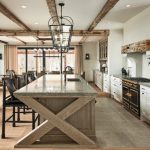Contemporary home decor is a term that is frequently used in the world of interior design, but what does it truly encompass? In this article, we will delve into the essence of contemporary home decor and explore its relevance and popularity in modern design trends.
Contemporary design has gained significant traction in recent years, capturing the attention of homeowners and designers alike. Its clean lines, minimalistic approach, and sleek aesthetics have made it a favored choice for those seeking a modern and timeless style. The essence of contemporary home decor lies in its ability to strike a balance between simplicity and sophistication, creating spaces that feel both inviting and effortlessly chic.
In this section, we will delve into the defining characteristics of contemporary home decor. From minimalist furniture choices to strategic lighting techniques, we will explore the key elements that contribute to creating a contemporary space. Understanding these characteristics will not only give you insight into what sets contemporary design apart but also provide you with inspiration for transforming your own living spaces.
The world of contemporary home decor is constantly evolving as new ideas surface and innovation takes center stage. By grasping the concepts outlined in this article and exploring different aspects of contemporary design, you can create unique and stylish interiors that reflect your personal taste while embracing the timeless essence of contemporary home decor. So let’s dive in and uncover what makes contemporary design such an influential force in today’s ever-changing world of interior design.
Characteristics of Contemporary Home Decor
Contemporary home decor is defined by a set of key features and defining elements that distinguish it from other interior design styles. One of the most prominent characteristics of contemporary home decor is its minimalistic and sleek nature. The use of clean lines and simplicity in furniture, accessories, and overall design creates a sense of modernity and sophistication.
In contemporary home decor, less is more. This style emphasizes the idea of “less is more,” with an emphasis on open spaces and uncluttered environments. Furniture pieces in contemporary design are often simple, with clean lines and minimal ornamentation. The focus is on functionality and practicality without sacrificing style.
Another notable characteristic of contemporary home decor is the use of neutral color palettes. Contemporary spaces often feature neutral tones such as whites, grays, taupe, or beige. These colors create a peaceful and serene atmosphere while allowing other elements in the room to take center stage. However, pops of bold colors may also be incorporated to add visual interest and create focal points within the space.
Moreover, natural materials play a significant role in contemporary home decor. Wood, stone, glass, metal – these materials are often used to bring warmth and texture into the space. They provide a sense of authenticity while maintaining the sleekness associated with contemporary design.
Incorporating natural light into contemporary spaces is también importante (also important). Large windows and open floor plans allow for ample natural light to fill the room, enhancing the bright and airy ambiance that contemporary living spaces are known for.
Selecting Minimalistic Furniture
When it comes to selecting furniture for a contemporary home decor style, it’s crucial to choose pieces that align with the minimalist aesthetic. Look for furniture designs that have clean lines and a streamlined silhouette. Avoid heavy or ornate furniture styles as they can detract from the desired modern look.
Opt for functional furniture that serves multiple purposes. In contemporary home decor, furniture should not only be visually appealing but also practical. Consider pieces with built-in storage or multifunctional features to maximize space and reduce clutter.
Materials for a Sleek and Modern Look
Materials play a significant role in achieving the sleek and modern look of contemporary home decor. Contemporary design often incorporates materials like metal, glass, and leather to create a sense of sophistication.
Metallic finishes are commonly used in contemporary spaces to add a touch of elegance and glamor. Stainless steel, chrome, or brushed nickel are popular choices for fixtures such as lighting, faucets, and cabinet hardware.
Glass is another material that is frequently used in contemporary home decor to bring in transparency and lightness. Glass coffee tables, dining tables with glass tops, and see-through shelving units are just some examples of how glass can be incorporated to achieve a sleek appearance.
Leather upholstery adds a luxurious element to contemporary spaces. Leather sofas or chairs can serve as statement pieces while maintaining the clean lines characteristic of this design style.
Incorporating Minimalistic Furniture in Contemporary Home Decor
Minimalism is a key characteristic of contemporary home decor, and selecting the right furniture plays an important role in achieving this aesthetic. In contemporary design, furniture should be simple, functional, and visually lightweight to maintain the clean lines and sleek appearance that define this style. When choosing furniture for a contemporary space, it is essential to prioritize pieces that complement the overall minimalistic theme.
One popular choice for minimalistic furniture in contemporary home decor is sleek and low-profile sofas and chairs. These pieces often feature straight lines and smooth surfaces, creating a minimalist yet comfortable seating area. Leather and microfiber are commonly used materials for upholstery in contemporary design due to their smooth textures and durability.
Aside from seating options, tables also play a significant role in achieving a minimalistic look. Coffee tables with clean lines and sharp edges are highly favored in contemporary decor. Glass or metal tops paired with thin legs add a sense of lightness to the space. Additionally, console tables or side tables with slender frames can help maintain an open and airy feel.
To further enhance the minimalist aesthetic, incorporating storage solutions that blend seamlessly into the design is crucial. Minimalistic shelving units or bookcases with simple geometrical shapes provide both functionality and visual appeal without overwhelming the overall space.
| Furniture | Characteristics |
|---|---|
| Sleek Sofas | Straight lines, low-profile, leather/microfiber upholstery |
| Minimalist Coffee Tables | Clean lines, sharp edges, glass/metal tops |
| Console Tables | Thin legs, simple frames |
| Minimalistic Shelving Units | Geometrical shapes, blend seamlessly into space |
By selecting furniture that adheres to the principles of minimalism, contemporary homes can achieve a visually pleasing and clutter-free environment. These minimalist pieces not only create a sense of simplicity but also contribute to an overall sleek and modern look. When combined with other key elements of contemporary design like neutral color palettes and clean lines, incorporating minimalistic furniture becomes an essential step in creating a cohesive and inviting contemporary space.
The Power of Lighting in Contemporary Home Decor
Contemporary home decor places a strong emphasis on the power of lighting to create ambiance and enhance the overall design aesthetic. Lighting plays a crucial role in contemporary spaces, as it not only illuminates the room but also helps to highlight architectural features and create a desired atmosphere. Various lighting techniques and fixtures are utilized to achieve a sleek and modern look.
One of the key aspects of lighting in contemporary home decor is the use of recessed lighting. Recessed lights are installed into the ceiling, providing an unobtrusive and streamlined lighting option. They create a soft, even glow that helps to brighten up the space without drawing attention away from other design elements.
Pendant lights are also commonly used in contemporary spaces, adding both functionality and style. These hanging light fixtures come in various shapes, sizes, and materials, allowing homeowners to choose options that complement their overall design theme.
Another popular lighting option in contemporary home decor is track lighting. Track lights are installed on a flexible track system that can be adjusted and directed to highlight specific areas or objects within a room. This versatility makes track lighting an ideal choice for showcasing artwork or architectural details. The ability to control the direction and intensity of light allows homeowners to create different moods and focal points throughout their space.
To achieve optimal lighting in contemporary home decor, layering is often employed. Layering involves using different types of lights at varying heights and intensities to create depth and visual interest. For example, combining ambient, task, and accent lighting can help to establish different zones within a room while providing flexibility for various activities or tasks.
Incorporating adequate lighting plays a vital role in bringing out the best features of contemporary spaces while creating an inviting ambiance. By choosing the right type of fixtures and utilizing techniques like recessed lighting, pendant lights, track lighting, and layering, homeowners can effectively enhance their contemporary home decor with well-designed illumination.
| Lighting Elements | Description |
|---|---|
| Recessed Lighting | Installed in the ceiling, provides a soft and even glow, complements other design elements. |
| Pendant Lights | Hanging fixtures that add both functionality and style, come in various shapes, sizes, and materials. |
| Track Lighting | Mounted on a flexible track system, can be adjusted to highlight specific areas or objects. |
| Layering | The use of different lighting types at varying heights and intensities to create depth and visual interest. |
Contemporary Color Schemes and Textures
Contemporary home decor is characterized by clean lines, minimalism, and a focus on function. One of the key elements that contribute to the overall aesthetic of contemporary design is the color scheme. In contemporary spaces, neutral colors are often favored for their ability to create a sense of simplicity and serenity. Cool tones such as gray, white, and beige are commonly seen in contemporary interiors, but bold pops of color can also be incorporated to add visual interest.
In addition to color, textures play a crucial role in contemporary home decor. Texture adds depth and dimension to a space, enhancing the overall visual appeal. In contemporary design, textures like glass, metal, and wood are frequently used to create contrast and add tactile interest. These materials can be incorporated through furniture pieces or decorative accessories like light fixtures or accent tables.
When selecting textiles for a contemporary space, it’s important to consider materials with modern finishes such as crisp linens or smooth leather. These fabrics not only contribute to the overall aesthetic but also have a functional aspect as they are often easy to clean and maintain. Layering different textures through rugs or throw pillows can also help create visual interest while maintaining a cohesive contemporary style.
The Role of Art and Accessories in Contemporary Home Decor
Contemporary home decor is not solely focused on furniture and color schemes, but also places a significant emphasis on art and accessories. The role of art and accessories in contemporary design is to enhance the overall aesthetic, add visual interest, and create focal points within the space. By strategically incorporating curated pieces that align with the minimalist and sleek characteristics of contemporary style, homeowners can elevate the look and feel of their interiors.
One of the key elements in contemporary home decor is the use of abstract art. Abstract art often features bold colors, geometric shapes, and unconventional compositions that can bring a sense of energy and vibrancy to a space. It serves as an excellent way to inject personality into an otherwise clean and minimalistic interior. Large-scale abstract paintings or sculptures can be used as striking focal points in living rooms or dining areas.
Geometric shapes are another prevalent feature in contemporary design, making them ideal for adding interest to walls or even as sculptural decor pieces. Circles, squares, triangles, and hexagons are commonly used shapes that can be found on artwork, shelves, mirrors, or patterned textiles. These geometric elements create a visually pleasing balance while adding depth to the overall design.
Minimalistic sculptures are also popular choices for contemporary home decor. The clean lines and simple forms of these sculptures provide an additional layer of visual interest without overwhelming the space. Sculptures made from materials such as metal or stone complement the modern aesthetic while adding a touch of sophistication.
In addition to art, carefully chosen accessories can make a significant impact on the overall ambiance of a contemporary space. Minimalistic vases with simple silhouettes can add a touch of elegance while effortlessly blending into the surrounding decor. Mirrors with sleek frames not only serve functional purposes but also reflect light and create an illusion of a larger space.
It is important to remember that in contemporary home decor, less is more when it comes to accessories. It’s better to select a few high-quality pieces that truly stand out rather than cluttering the space with too many smaller items. By incorporating curated art and accessories that align with the minimalist and sleek characteristics of contemporary style, homeowners can showcase their personal style while maintaining a cohesive and visually pleasing interior design.
Creating Balance and Harmony in Contemporary Home Decor
Creating balance and harmony is crucial in contemporary home decor to achieve a cohesive and visually pleasing space. The clean lines and minimalistic nature of contemporary design can sometimes lead to a sense of sterility, but by incorporating certain techniques, you can create an inviting atmosphere that exudes balance and harmony.
One important technique to achieve balance in contemporary home decor is through symmetrical arrangements. This means arranging furniture, art, and accessories in a way that creates a mirror image or equal distribution on either side of a central focal point. Symmetry brings a sense of orderliness and equilibrium to a space. For example, placing two identical armchairs on either side of a coffee table or hanging matching artwork on both sides of a television can create a beautifully balanced look.
Proportion and scale also play key roles in achieving balance in contemporary home decor. It’s important to ensure that furniture pieces are appropriately sized for the space they occupy. Oversized furniture can overpower the room, while undersized pieces may appear insignificant or out of place. By carefully considering the scale of each item and how it relates to the overall space, you can create a harmonious arrangement where everything feels well-proportioned.
In addition to careful furniture placement, open floor plans are commonly found in contemporary design as they promote a sense of flow and spaciousness. Removing unnecessary walls creates an open and airy feeling while allowing natural light to fill the space. To maintain balance within an open floor plan, it’s important to strategically place furniture so that it defines separate areas without blocking the visual flow between them.
To further enhance harmony in contemporary home decor, minimal clutter is essential. Avoid excessive ornamentation or overcrowding with too many accessories or decor items. Each piece should have intentionality and purpose within the room rather than simply filling up space. Strategic placements should create focal points or accents throughout the space without overwhelming the overall design.
By incorporating these techniques of creating balance and harmony, you can elevate your contemporary home decor to the next level. Remember that contemporary design is about simplicity, clean lines, and minimalism, but it doesn’t mean sacrificing warmth or comfort. With careful planning and attention to detail, your contemporary space can be a harmonious oasis that reflects your personal style and creates a welcoming environment for both residents and guests.
Incorporating Natural Elements in Contemporary Home Decor
One of the growing trends in contemporary home decor is the integration of natural elements into modern design. This shift towards incorporating nature into interior spaces stems from a desire to create a sense of tranquility and connection to the outdoors. By incorporating sustainable materials, indoor plants, and natural textures, homeowners can achieve a harmonious balance between contemporary aesthetics and the beauty of nature.
One way to incorporate natural elements into contemporary home decor is through the use of sustainable materials. This can include using reclaimed wood for flooring or furniture, or opting for eco-friendly materials such as bamboo or cork. Not only do these materials add warmth and texture to a space, but they also contribute to a more sustainable and environmentally conscious lifestyle.
Another way to bring nature indoors is by introducing indoor plants into contemporary spaces. Plants not only add a touch of greenery, but they also purify the air and create a calming atmosphere. Incorporating large potted plants as statement pieces or adding smaller succulents on shelves or windowsills can instantly breathe life into any room.
Furthermore, incorporating natural textures such as stone, rattan, or jute can enhance the overall aesthetic of contemporary home decor. These textures add depth and visual interest while creating a tactile experience for occupants. Whether it’s using stone tiles in the bathroom or introducing rattan furniture in the living room, incorporating these natural textures creates a harmonious blend between contemporary design and organic elements.
Incorporating natural elements not only adds an element of serenity to contemporary spaces but also brings us closer to our roots. As people continue to seek solace in nature amidst busy urban environments, integrating these elements into our homes becomes even more important. By embracing sustainable materials, indoor greenery, and natural textures, homeowners can create an inviting sanctuary that nourishes both the body and soul within the framework of contemporary home decor.
Conclusion
In conclusion, contemporary home decor offers a timeless and ever-evolving approach to design that continues to capture the attention of homeowners and interior designers alike. Throughout this article, we have explored the defining characteristics of contemporary home decor, such as minimalistic and sleek lines, neutral color palettes, and natural materials. We have also discussed the importance of selecting minimalistic furniture and incorporating strategic lighting to create ambiance in contemporary spaces.
Furthermore, we have highlighted the significance of color schemes, textures, art and accessories, balance and harmony, as well as the integration of natural elements in contemporary design. These elements allow individuals to personalize their spaces while still adhering to the core principles of contemporary home decor.
What makes contemporary home decor truly special is its ability to adapt and evolve with time. While it maintains its minimalist roots, contemporary design embraces new ideas and innovations that reflect the changing needs and preferences of modern society. This flexibility allows homeowners to experiment with different styles within the realm of contemporary home decor while still maintaining a cohesive and harmonious overall look.
In essence, contemporary home decor offers an exciting blend of simplicity, functionality, and creativity. It is a design style that encourages individuals to express their personal tastes and preferences while embracing the principles that define this aesthetic.
By applying the principles discussed throughout this article – from selecting furniture to incorporating natural elements – readers can create their own contemporary spaces that are both timeless and reflective of their unique personalities. So go ahead, embrace the versatility of contemporary home decor and make your space truly your own.

I’m thrilled to be your companion on this exciting journey through the world of home decor and design. With a passion for turning houses into homes and a keen eye for the finer details, I’m here to help you transform your living spaces into beautiful, functional, and meaningful havens.





